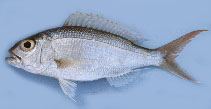| Family: |
Lutjanidae (Snappers), subfamily: Etelinae |
| Max. size: |
70 cm TL (male/unsexed); max.weight: 2,200.0 g; max. reported age: 11 years |
| Environment: |
demersal; marine; depth range 40 - 120 m |
| Distribution: |
Eastern Indian Ocean: Andaman Sea. Western Pacific: New Guinea to Sumatra, north to the Ryukyu Islands. Present in Australia from the North West Shelf to Tweed Heads in New South Wales (Ref. 6390). Records from the western Indian Ocean need verification. |
| Diagnosis: |
Dorsal spines (total): 10-10; Dorsal soft rays (total): 11-12; Anal spines: 3-3; Anal soft rays: 8-8. Interorbital space flat. Bases of dorsal and anal fins without scales, their last soft rays extended into short filaments. Pectoral fins long, reaching level of anus. Scale rows on back parallel to lateral line. Overall color rosy red; the top of the head with longitudinal vermiculated lines and spots of brownish yellow; the dorsal fin with wavy yellow lines. |
| Biology: |
Sharptooth snappers are found in tropical and sub-tropical deep waters. They are found in schools and live in areas of hard, rocky and uneven sea floor (Ref. 27354). They feed on benthic invertebrates and fishes. |
| IUCN Red List Status: |
Least Concern (LC); Date assessed: 05 March 2015 Ref. (130435)
|
| Threat to humans: |
harmless |
Source and more info: www.fishbase.org. For personal, classroom, and other internal use only. Not for publication.

